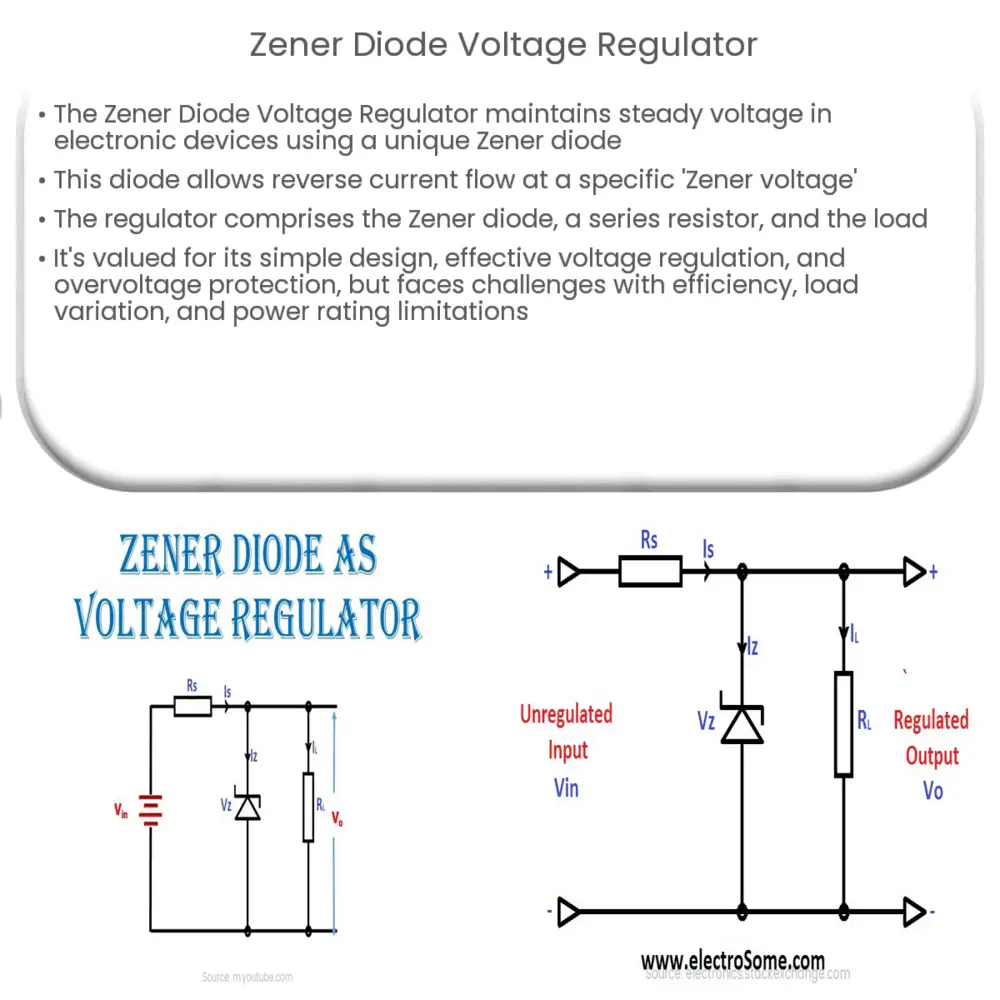Explore the fundamentals of Zener Diode Voltage Regulators: their operation, components, advantages, and limitations in electronics.

Zener Diode Voltage Regulator: An Overview
The term ‘Zener Diode Voltage Regulator’ is used to describe a type of voltage regulator, an essential component in any electronic device or circuit. A voltage regulator’s primary function is to maintain a steady voltage level, thereby ensuring the safe and efficient operation of the device or circuit.
A Zener Diode Voltage Regulator uses a special type of diode, known as a Zener diode, to perform this regulation function. The Zener diode, named after Clarence Melvin Zener who discovered the Zener effect, is unique due to its ability to allow current to flow in the reverse direction when a specific ‘Zener voltage’ is reached.
The Principle of Operation
The operation of a Zener Diode Voltage Regulator is based on the principle of Zener breakdown or Zener effect. This is a quantum mechanical effect where, at a specific reverse voltage, the diode allows current to flow in the reverse direction. This characteristic is exploited to maintain a constant output voltage in a circuit, despite variations in input voltage or load current.
When the input voltage is less than the Zener voltage, the Zener diode acts as an open circuit, and no current flows through it. However, when the input voltage exceeds the Zener voltage, the diode ‘breaks down’ and allows current to flow in the reverse direction, thereby limiting the voltage across the load to the Zener voltage.
Components of a Zener Diode Voltage Regulator
- Zener Diode: The key component in this type of regulator. It is connected in parallel with the load to regulate the voltage.
- Series Resistor (Rs): This resistor is connected in series with the Zener diode and the load. Its role is to limit the current flowing through the circuit, protecting the diode and ensuring stable operation.
- Load (RL): This represents the device or circuit being powered by the voltage regulator.
Together, these components form a simple, yet effective, voltage regulation system. The performance of a Zener Diode Voltage Regulator depends on factors such as the Zener voltage, the series resistance, and the load resistance.
Advantages and Disadvantages of Zener Diode Voltage Regulators
Zener Diode Voltage Regulators, like any other components in electronics, have their pros and cons, which are often taken into account when designing circuits.
Advantages:
- Simple Design: One of the most significant advantages of a Zener Diode Voltage Regulator is its simplicity. The design only requires a resistor and a Zener diode, making it easy to implement.
- Effective Voltage Regulation: Zener diodes are very effective at maintaining a constant voltage output, even when the input voltage or load conditions vary. This makes them reliable components in many electronic devices.
- Overvoltage Protection: The Zener diode can also act as a protective device, preventing circuits from experiencing damaging voltage levels.
Disadvantages:
- Efficiency: One of the drawbacks of the Zener Diode Voltage Regulator is its efficiency. Since it operates through the dissipation of excess energy as heat, it can be inefficient, especially at higher currents.
- Load Variation: Although the Zener diode is effective at maintaining a constant voltage, its performance can be affected by significant changes in load current.
- Power Rating: Zener diodes are usually limited to low power applications due to their relatively low power ratings.
Conclusion
The Zener Diode Voltage Regulator is a crucial component in the world of electronics, offering simple and effective voltage regulation. Despite its limitations, it is widely used in various applications due to its advantages, such as simplicity, effective voltage regulation, and overvoltage protection. Understanding the operation and characteristics of the Zener Diode Voltage Regulator is fundamental for anyone interested in electronics, whether for hobbyist projects or professional electronic design. As technology evolves, so too will the capabilities and applications of these essential components.

